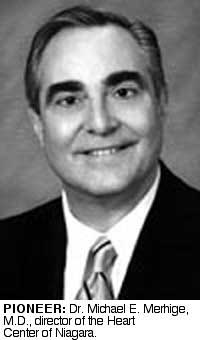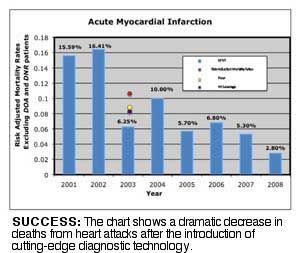
In 2003, a landmark study was published that showed Niagara County ranked No. 1 for deaths from heart disease out of 3,141 counties in America.
An admixture of factors including genetics, lifestyle, environment, obesity, the prevalence of diabetes and high blood pressure, and economics contributed to this distinction.

In response to this news, the Niagara Falls Memorial Medical Center raised $20 million through grants and private contributions to create "The Heart Center of Niagara."
It put Memorial on the cutting edge of medical technology and the death rate from patients experiencing heart attacks dropped from 16 percent in 2003 to 2.8 percent by 2008.
A twofold feature -- the Heart Center's state-of-the-art diagnostic technologies and the fact that it is available 24 hours per day -- make Memorial unique.
The technologies -- Positron Emission Tomography or PET scanning and Computed Tomography or CT angiography -- provide accurate, pictorial information about the blood flow in a patient's coronary arteries and any blockages that may be present.
Unlike a standard angiogram, where the groin or wrist is numbed and an IV is inserted into an artery, and a catheter reaches into the aortic arch, at considerable pain and some risk, the PET and CT are painless, safe, and the results are immediate.
Its landmark application at Memorial is that it is attached to the emergency room.
The Heart Center is located on the floor above the ER. In the emergency room setting, PET and CT technology can save lives because, along with an EKG, lab tests and a physician's examination, it can reliably tell an ER doctor if the patient is having a heart attack.
If the patient is administered clot-busting drugs (thrombolytics) to open up a blocked artery, a subsequent PET retest can tell the physician if the thrombolytic was successful.
If it is determined the patient needs angioplasty, stenting or a surgical intervention such as coronary bypass, Memorial can stabilize the patient and transport him to ECMC or Buffalo General Hospital.

"I don't think there's a place in the world that has PET, attached to an emergency room available 24/7," said Dr. Michael E. Merhige M.D., director of the Heart Center.
"The concept," Dr. Merhige explained, "was to bring in very accurate, non-invasive imaging.
The PET scanner allows us to look at a picture of blood flow, a snapshot if you will, when the patient is in the camera. We can image patients 24/7, make a decision as to whether their chest pain was a heart attack, and make a decision whether to give them thrombolytic therapy or send them to ECMC or Buffalo General for an emergency angiogram.
"With heart attacks you have a six-hour window in which to re-establish blood flow if you're going to salvage myocardium. It doesn't lend itself to the typical standard of care before this technology was employed, which was admission, watch the cardiac enzymes for a few days and set the patient up for an elective angiogram."
The PET scan works by intravenously sending a tracer into the bloodstream. The tracer is extracted by the heart muscles from the blood in proportion to the blood flow so a doctor can see if there is a place where the tracer did not get. If it did not, it means there is a blockage.
At the Heart Center, Dr. Merhige also works with outpatients to provide non-surgical management and care to halt and, in some cases, reverse the progress of heart disease.
PET scanning and CT angiography can detect the presence of coronary artery disease months or even years before the patient experiences symptoms such as chest pain or shortness of breath.
"In the routine maintenance of patients," Dr. Merhige said, "we can look at the flow, which is from the PET scan, as well as look at the anatomy from the CT scan. We can get a very sophisticated 'look' without having to do invasive angiography." PET scanning can detect very mild Coronary Artery Disease before it leads to an actual narrowing.
"My practice is basically trying to prevent the problem and then trying to address it when it's too late to prevent the problem," said Dr. Merhige. "But I do it perched on ER, so when, as it happens about four times a week, somebody comes in with a heart attack, we turn our attention to that and see what we can do."
The presence of cutting-edge PET technology and an aggressive focus on preventive diagnosis at Memorial not only has saved lives, but reduces unnecessary, costly and potentially dangerous angiograms.
An invasive coronary angiogram is a $7,000 test that can sometimes induce heart attack, stroke or kidney failure. The PET scan is about $1,850 and the ER test is $900.
Typically, two thirds of those who receive invasive angiograms did not require the procedure. They could have been diagnosed with non-invasive testing available at Memorial.
"The emergency room setting, where this technology is available 24/7, has had a significant impact on our mortality and that was our endpoint," said Dr. Merhige. "From my standpoint, if I were going to have a heart attack, anywhere in Western New York, my preference would be to be seen in the ER right here."
Niagara County, in 2011, is no longer the heart disease capital of America. Much still has to be done.
Dr. Merhige explained, "The community needs to know if they have 'chest discomfort,' if they have unusual, odd fatigue, or breaking out in sweats, or something is the matter that they have never felt before, they need to get here faster rather than slower.
"If you're fat, if you're a smoker, if you're a diabetic, if you've got high blood pressure, if you have a family history of a heart attack or if you have had one before, or bypass surgery, then you ought to come, get a PET scan, see where you are at, get your medications optimized, maybe get on a 'tight diet,' get off cigarettes, then come back ... to see if we made an impact on your coronary disease.
"What we have to offer is kind of 'the report card.'
"Two years later, you're either better, worse or the same. If your primary doctor and you see your own PET scan pictures getting worse, in general, you might think, 'Gee, I better do something about this because this really is getting worse.'"
Today, Memorial is at the forefront of both emergency and non-emergency care of heart patients.
"I would say it is quite safe to say we have the most aggressive approach to prevention in Western New York." Dr. Merhige said. "Coronary disease reversal and prevention: That's the business we're in."
| Niagara Falls Reporter | www.niagarafallsreporter.com | March 8, 2011 |